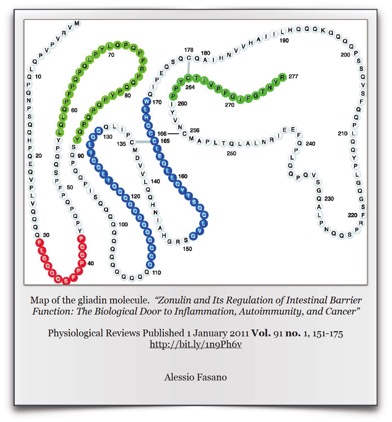The Risks of Cheating
This article originally appeared in our January 2016 newsletter. Due to the [unexpected] overwhelming positive feedback, I decided to improve it and post it here.
I hope you find it helpful.
Stay strong & keep moving forward.
Alan Klapperich
GIG of ECW Branch Manager

While many find it a blessing their condition can be controlled by a "simple diet" change, others consider it a curse of biblical proportions. It's no secret, transitioning to the gluten-free lifestyle can be tough. [Notice the word - lifestyle. The changes required go far beyond just diet.]
A new lifestyle requires the desire to change, knowledge of how to make the change, and the dedication and motivation to stay the course. Yes, it's quite a departure from the previous lifestyle of eating anything from anywhere at anytime.
Barriers to Compliance
When it comes to dietary compliance for the gluten-free diet, there are many barriers that must be broken down:
- Time constraints for cooking or preparing food
- Misinformation
- Lack of knowledge or education (label reading, recognizing gluten)
- Lack of cooking skills
- Ability to manage emotions: depression, anxiety, fear
- Ability to resist temptation
- Feelings of deprivation
- Gluten-Free food availability (may be hard to find)
- Financial restrictions (GF diet can be expensive)
- Social pressures
- Peer pressures
- Travel
- Lack of symptoms
- Effectiveness of the diet (it doesn’t appear to help)
This list seems almost endless, but unfortunately it's still incomplete.
It seems that removing gluten is easier said than done. Give up the foods that you’ve been eating for your entire life? That’s crazy talk!
"I need gluten. I can't live without gluten!"
Ironically, a heroin addict might say something very similar. This is not surprising since narcotics and gluten are addictive. Yes, let’s add "addictive" and "withdrawal symptoms" to the barriers of compliance list.
Addictive? Withdrawal? Seriously?
Yes, yes, and yes. Read on Macduff…

Think of gluten as a string of pearls that must be broken down into individual pearls [known as amino acids].
Humans do not have the enzymes to completely break down gluten into individual amino acids.
Large fragments [known as peptides] of undigested gluten remain after digestion.
Some of those peptides are known as gluteomorphins.
Due to increased intestinal permeability [also known as "Leaky Gut"], the gluteomorphins pass through intestinal wall and enter the blood stream.
Gluteomorphins react with the opiate receptors in the brain, just like heroin and morphine.
This reaction creates a craving - generating the desire for more of the substance.
Julianne Taylor, RN offers up a great explanation on how gluten creates an autoimmune reaction.
http://bit.ly/2vAO4hd or http://bit.ly/2Jgh3ZO
….and now, back to our regularly scheduled article…
Complications of Untreated Celiac Disease
While it may be easy to rationalize away gluten cheats as simple, temporary aches and pains or as minor [major] inconveniences - beneath the surface, your body could be gearing up for a civil war that would put Gettysburg to shame.

A 2015 study published by The Celiac Center at Beth Israel Deaconess Medical Center (BIDMC) found that 75.5% of the study participants had adequate gluten-free diet adherence.
So what about the other one-fourth (24.5%)? They may be setting themselves up for additional [often serious] medical conditions.
Some of the possible complications of cheating:
- Increased risk of heart attacks & stokes
- Increased risk of blood clots & Deep Vein Venous Thrombosis (DVT)
- Heart muscle damage
- Heart rhythm problems
- Coronary Artery Dissection
- Anemia
- Bone loss
- Cancers
- Ulcerative jejunitis
- Collagenous sprue
- Depression
- Malnutrition
- Neurological disorders
- Infertility
- Miscarriage
- Increased risk of triggering additional associated autoimmune conditions
by Linda J. Dobberstein, DC
http://bit.ly/1TDnOnE
7 Serious Complications of Untreated Celiac Disease
by Sarah Patrick
http://bit.ly/1OyRQZE
Complications of Untreated Non-Celiac Gluten Sensitivity
Think you can escape the risks because you have non celiac gluten sensitivity? Sorry, gluten can still rear its ugly head with the likes of:
- Eczema
- Psoriasis
- Depression
- Peripheral Neuropathy
- ADHD
- Multiple Sclerosis
- Ataxia
- Diabetes
- Amyotrophic Lateral Sclerosis (Lou Gerhig's Disease)
- and potentially much more
To learn more about the above list, please check out this link:
by Chris Kresser, M.S., L.Ac
http://bit.ly/1n5wysf
ChChChChanges in Behavior
"Change is not measured in leaps and bounds but in the small steps we take toward a larger goal." ~Claire Dorotik-Nana LMFT
The Barriers to Compliance list above consists of things we can control and things we cannot control. Fear not, this lack of control does not a victim make.
The good news - we get to choose how we react in those situations; if we don't like it - we can change it.
The bad news - change is not always easy and requires effort.
The links below offer some information on how to make the changes that can lead to healthier, happier lives.
The Stages of Change
by Kendra Cherry
http://abt.cm/1ZxH2wA
"Understanding the elements of change, the stages of change, and ways to work through each stage can help you achieve your goals"
5 Steps to Changing Any Behavior
by Alex Lickerman, MD
http://bit.ly/1PCurD7
"Always remember: none of us was born with any habits at all. They were all learned, and can all, therefore, be unlearned. The question is: how badly do you really want to change?"
NursingTimes.net Vol 107 No 23 06/11/2014 - "Healthier lifestyles: behaviour change"
by Nicola Davies
http://bit.ly/1JPubUJ
"Unhealthy lifestyle choices such as smoking and poor diet are significant and preventable causes of long-term conditions. Nurses are well placed to encourage and support patients to make healthy choices. Through good communication, collaboration and goal-setting, behaviour change is possible. This article discusses evidence for the best ways to initiate and sustain behaviour change."
How to Withstand Food Peer Pressure
by Karen Diaz, RD
http://huff.to/1OMFmKx
When you are trying to listen to your body, food peer pressure can be the last straw making you throw in the towel. Here are four important ways to withstand food peer pressure.
How many celiacs in Wisconsin?

Now there could be a few variations of this question:
How many diagnosed celiacs?
How many potential celiacs?
Since I don't have time to research "How many diagnosed celiacs", I'm going to answer "How many potential celiacs?". Since we know the general prevalence of celiac, we can calculate an estimate.
First we start with population of Wisconsin
According to the 2010 US Census Bureau, Wisconsin has a population of 5,686,986.
Next we need the prevalence of celiac disease
A 2003 ground breaking medical study conducted by Dr. Fasano determined that ...
1 in 133 of normal, healthy people have Celiac Disease [most do not know it].
1 in 56 of those that have related symptoms.
1 in 39 of those that have a 2nd degree relative [aunt or cousin] with Celiac Disease.
1 in 22 in those that have a 1st degree relative [parent or sibling] with Celiac Disease.
Celiac Disease affects about 1% (3 million) of the population in the USA.
Time to fire up the calculator
If we apply the 1 in 133 - we get an estimate of 42,759 people
If we apply the 1% - we get an estimate of 56,869 people that potentially could have CD
We can estimate the number of diagnosed. According to Dr. Peter Green only about 10% of the 1% are actually diagnosed.
If we apply 10% to the 1% - we get an estimate of 5,686 diagnosed celiacs in Wisconsin.
A bit more math reveals this: approximately 51,183 people are currently undiagnosed.
Non-Celiac Gluten Sensitivity aka The Gluten Syndrome
Would you like to see an even larger number? It estimated that Non-Celiac Gluten Sensitivity affects anywhere from 6% to 40% of the population.
6% of 5,686,986 = 341,219 people that gluten affects adversely.
40% of 5,686,986 = 2,274,794 people that gluten affects adversely
That's a lot of people! Now, let's calculate the healthcare dollars chewed up because of gluten. Ooops, I don't have a calculator big enough for that task! "Hello NASA? Yeah, this is Al from GIG of ECW..."
If you'd like to calculate the numbers of your home town, check out our Celiac Disease/Non Celiac Gluten Sensitivity Calculator.
Would you like to see these numbers broken down by county? Here ya go...
Wisconsin CountiesEstimated number of people with Celiac & NCGS County 2010 CensusPopulation Est. # of Celiacs1% Est. # of DX Celiacs10% of 1% NCGS6% NCGS10% NCGS40% Adams 20,875 209 21 1,253 2,088 8,350 Ashland 16,157 162 16 969 1,616 6,463 Barron 45,870 459 46 2,752 4,587 18,348 Bayfield 15,014 150 15 901 1,501 6,006 Brown 248,007 2,480 248 14,880 24,801 99,203 Buffalo 13,587 136 14 815 1,359 5,435 Burnett 15,457 155 15 927 1,546 6,183 Calumet 48,971 490 49 2,938 4,897 19,588 Chippewa 62,415 624 62 3,745 6,242 24,966 Clark 34,690 347 35 2,081 3,469 13,876 Columbia 56,833 568 57 3,410 5,683 22,733 Crawford 16,644 166 17 999 1,664 6,658 Dane 488,073 4,881 488 29,284 48,807 195,229 Dodge 88,759 888 89 5,326 8,876 35,504 Door 27,785 278 28 1,667 2,779 11,114 Douglas 44,159 442 44 2,650 4,416 17,664 Dunn 43,857 439 44 2,631 4,386 17,543 Eau Claire 98,736 987 99 5,924 9,874 39,494 Florence 4,423 44 4 265 442 1,769 Fond du Lac 101,633 1,016 102 6,098 10,163 40,653 County 2010 CensusPopulation Est. # of Celiacs1% Est. # of DX Celiacs10% of 1% NCGS6% NCGS10% NCGS40% Forest 9,304 93 9 558 930 3,722 Grant 51,208 512 51 3,072 5,121 20,483 Green 36,842 368 37 2,211 3,684 14,737 Green Lake 19,051 191 19 1,143 1,905 7,620 Iowa 23,687 237 24 1,421 2,369 9,475 Iron 5,916 59 6 355 592 2,366 Jackson 20,449 204 20 1,227 2,045 8,180 Jefferson 83,686 837 84 5,021 8,369 33,474 Juneau 26,664 267 27 1,600 2,666 10,666 Kenosha 166,426 1,664 166 9,986 16,643 66,570 Kewaunee 20,574 206 21 1,234 2,057 8,230 La Crosse 114,638 1,146 115 6,878 11,464 45,855 Lafayette 16,836 168 17 1,010 1,684 6,734 Langlade 19,977 200 20 1,199 1,998 7,991 Lincoln 28,743 287 29 1,725 2,874 11,497 Manitowoc 81,442 814 81 4,887 8,144 32,577 Marathon 134,063 1,341 134 8,044 13,406 53,625 Marinette 41,749 417 42 2,505 4,175 16,700 Marquette 15,404 154 15 924 1,540 6,162 Menominee 4,232 42 4 254 423 1,693 County 2010 CensusPopulation Est. # of Celiacs1% Est. # of DX Celiacs10% of 1% NCGS6% NCGS10% NCGS40% Milwaukee 947,735 9,477 948 56,864 94,774 379,094 Monroe 44,673 447 45 2,680 4,467 17,869 Oconto 37,660 377 38 2,260 3,766 15,064 Oneida 35,998 360 36 2,160 3,600 14,399 Outagamie 176,695 1,767 177 10,602 17,670 70,678 Ozaukee 86,395 864 86 5,184 8,640 34,558 Pepin 7,469 75 7 448 747 2,988 Pierce 41,019 410 41 2,461 4,102 16,408 Polk 44,205 442 44 2,652 4,421 17,682 Portage 70,019 700 70 4,201 7,002 28,008 Price 14,159 142 14 850 1,416 5,664 Racine 195,408 1,954 195 11,724 19,541 78,163 Richland 18,021 180 18 1,081 1,802 7,208 Rock 160,331 1,603 160 9,620 16,033 64,132 Rusk 14,755 148 15 885 1,476 5,902 St. Croix 84,345 843 84 5,061 8,435 33,738 Sauk 61,976 620 62 3,719 6,198 24,790 Sawyer 16,557 166 17 993 1,656 6,623 Shawano 41,949 419 42 2,517 4,195 16,780 Sheboygan 115,507 1,155 116 6,930 11,551 46,203 County 2010 CensusPopulation Est. # of Celiacs1% Est. # of DX Celiacs10% of 1% NCGS6% NCGS10% NCGS40% Taylor 20,689 207 21 1,241 2,069 8,276 Trempealeau 28,816 288 29 1,729 2,882 11,526 Vernon 29,773 298 30 1,786 2,977 11,909 Vilas 21,430 214 21 1,286 2,143 8,572 Walworth 102,228 1,022 102 6,134 10,223 40,891 Washburn 15,911 159 16 955 1,591 6,364 Washington 131,887 1,319 132 7,913 13,189 52,755 Waukesha 389,891 3,899 390 23,393 38,989 155,956 Waupaca 52,410 524 52 3,145 5,241 20,964 Waushara 24,496 245 24 1,470 2,450 9,798 Winnebago 166,994 1,670 167 10,020 16,699 66,798 Wood 74,749 747 75 4,485 7,475 29,900 Totals 5,686,986 56,870 5,687 341,219 568,699 2,274,794 ,